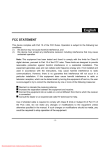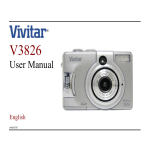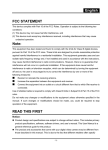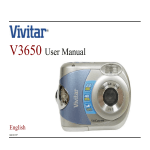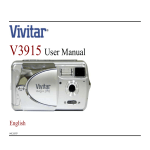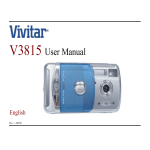Download Vivitar DVR-200 User manual
Transcript
DVR-200 User Manual English 040507TP FCC STATEMENT This device complies with Part 15 of the FCC Rules. Operation is subject to the following two conditions: (1) this device may not cause harmful interference, and (2) this device must accept any interference received, including interference that may cause undesired operation Note: This equipment has been tested and found to comply with the limits for Class B digital devices, pursuant to Part 15 of the FCC rules. These limits are designed to provide reasonable protection against harmful interference in a residential installation. This equipment generates, uses and can radiate radio frequency energy and, if not installed and used in accordance with the instructions, may cause harmful interference to radio communications. However, there is no guarantee that interference will not occur in a particular installation. If this equipment does cause harmful interference to radio or television reception, which can be determined by turning the equipment off and on, the user is encouraged to try to correct the interference by one or more of the following measures: Reorient or relocate the receiving antenna. Increase the separation between the equipment and receiver. Connect the equipment into an outlet on a circuit different from that to which the receiver is connected. Consult the dealer or an experienced radio/TV technician for help. Use of shielded cable is required to comply with Class B limits in Subpart B of Part 15 of the FCC rules. Do not make any changes or modifications to the equipment unless otherwise specified in the manual. If such changes or modifications should be made, you could be required to stop operation of the equipment. 1 SAFETY PRECAUTIONS Do not use this DV camera if it is emitting smoke (or an unusual odor), becomes unusually hot to be touched, produces a peculiar noise, or exhibits any other abnormal conditions. Do not expose the DV camera to moisture and make sure no water gets into the DV camera. Do not touch the power plug during a thunderstorm if you are using the AC power adapter. This may cause an electrical shock. Do not use the DV camera if any foreign objects have entered the DV camera. Do not place the DV camera in an unstable location such as on a wobbly table or sloping surface. Do not insert or drop metallic or other foreign objects into the camera through access points such as the SD memory card slot. Do not attempt to modify this DV camera. Never operate this DV camera in any way while driving a vehicle. Do not cover or wrap the DV camera or the AC power adapter with a cloth or quilt. Always use the DV camera and its accessories in well-ventilated locations. Handle the DV camera carefully and do not bump the DV camera into any hard object. Do not move the DV camera while it is switched on. (If you are using the AC power adapter, unplug the adapter from the AC power outlet after you have switched off the camera.) Ensure that any connector cords or cables to other devices are disconnected before moving the DV camera. When leaving the DV camera unused for long periods, such as during a vacation, always unplug the DV camera from the power source (batteries or AC power adapter) for safety. Handling the USB and AV cables on this product may expose you to lead, a chemical known to the State of California to cause birth defects or other reproductive harm. Wash hands after handling. 2 CONTENTS INTRODUCTION ........................................... 5 Overview .................................................................... 5 Package contents ..................................................... 6 Optional accessories ................................................ 6 CAPTURING STILL IMAGES ......................... 17 Basic settings ............................................................ 17 Digital zoom (Preview) ....................................... 17 Self-timer ............................................................. 18 Flash ................................................................... 19 Image resolution and quality .............................. 20 Number of recordable images ........................... 21 GETTING TO KNOW YOUR DIGITAL VIDEO CAMERA ....................................................... 7 Front view .................................................................. 7 Rear view ................................................................... 8 RECORD MODE ............................................ 22 LCD monitor information ........................................... 9 Recording video clips ............................................... 22 LED indicators and audible tones ............................ 12 Viewing video clips ................................................... 23 GETTING STARTED ...................................... 13 Installing the batteries ............................................... 13 Using an AC power adapter (optional accessory) ................................................. 14 Attaching the hand strap .......................................... 14 Inserting an SD memory card (optional accessory) ................................................. 15 Turning on your digital video camera ....................... 16 Setting the date and time .......................................... 16 PLAYBACK MODE ........................................ 24 Viewing images ......................................................... 24 Zoom playback .......................................................... 25 Displaying thumbnail images ................................... 26 Slide show display .................................................... 27 Deleting video clips and images .............................. 28 Delete one video clip/image at a time ............... 28 Delete all video clips/images at once ................ 29 Protecting video clips/images .................................. 30 Protecting one video clip/image ........................ 30 Removing protection from video clips and images ...................................... 30 3 SYSTEM CONNECTIONS ........................... 31 USB Driver for Windows 98 users ........................ 31 Installing PhotoSuite .............................................. 32 Installing PhotoVista .............................................. 33 Installing WinDVD Creator SVCD .......................... 34 MENU OPTIONS ........................................ 35 Record menu ......................................................... 35 Image size ...................................................... 36 Image quality .................................................. 36 Video quality ................................................... 36 Exposure ......................................................... 36 White balance ................................................. 38 ISO .................................................................. 39 Setup Menu ............................................................ 40 Format ............................................................. 41 Beep ................................................................ 41 Speaker ........................................................... 42 LCD brightness ............................................... 42 Power off .......................................................... 43 Reset to default ................................................ 43 Date type ......................................................... 44 Date setup ....................................................... 44 Date imprint ..................................................... 44 Video out frequence ........................................ Light frequency. ............................................... 45 Language ........................................................ 45 4 Playback Menu .......................................................... 46 Protect ............................................................. 46 Delete all .......................................................... 47 Slide show ....................................................... 47 Copy to card .................................................... 47 CONNECTING YOUR DITIGITAL VIDEO CAMERA TO OTHER DEVICES ........................................... 48 CAMERA SPECIFICATIONS ......................... 49 APPENDIX ................................................... 50 Error messages ........................................................ 50 INTRODUCTION Overview Your new digital video camera is a miniature camcorder that will capture motion video as well as 2 megapixel still images. Using the 1.5" TFT color image LCD monitor, you can record images and then review them in detail. 64MB internal (built-in) memory lets you capture and store video and images without the need for an additional memory card. However, you may wish to expand the memory capacity of your camera (up to 512 MB) by purchasing a Secure Digital (SD) memory card. Video clips and images that you have captured can be transferred to your computer using the USB cable. A USB driver is required only for Windows 98 users. Windows Me/2000/XP users may simply plug their camera directly into a USB port on their PC and begin transferring images to your computer. If you have a memory card, you may also wish to purchase an SD card reader for your PC. A card reader makes downloads even faster and more efficient. You can enhance and retouch your images and videos on your computer using the provided editing software, or other software you may already own. You may share your images and videos with your friends via e-mail, in a report, or on a website. The possibilities are endless. When shooting digital still images, an automatic flash sensor detects the shooting (lighting) conditions and determines whether the flash should be used for your digital still images. This feature helps ensure that your still images turn out right. We truly hope you enjoy your new DV camera! 5 Package contents Carefully unpack your new DV camera and ensure that you have the following items. In the event that any item is missing or damaged, promptly contact Vivitar Customer Service. Digital video camera User’s manual USB cable AV cable Camera strap Camera pouch Software CD-ROM Optional accessories SD memory card AC power adapter 2 x AA alkaline batteries Note: The product and accessories that come with your camera may be different from those described in this manual. This is due to the fact that different retailers often specify slightly different product inclusions and accessories to suit their market requirements, customer demographics, and geographical preferences. Products often vary between retailers especially with accessories such as batteries, chargers, AC adapters, memory cards, cables, carrying cases/pouches, and language support. Occasionally a retailer will specify a unique product color, appearance, and internal memory capacity. Contact your dealer for precise product definition and included accessories. For drivers, revisions to this manual, and manuals in other languages please updates, refer to our website. 6 GETTING TO KNOW YOUR DIGITAL VIDEO CAMERA Front view 1. Lens 2. Microphone 3. Flash 4. Self-timer LED 5. Battery/SD card cover 6. Tripod socket 7 Rear view 1. LCD monitor 2. Speaker 3. Power/Menu button 4. Arrow (up) Flash 5. Arrow (right) T Zoom in 6. Arrow (down) Self-timer 7. Arrow (left) W Zoom out 8. Record/ Stop 9. System LED indicator 10. OK OK Digital zoom 11. Still-Image shutter 12. Delete 13. Playback Pause 14.A/V OUT (Audio/Video Out) jack 15.USB connector 16.DC-in connector 17.Strap eyelet 8 LCD information These indicators are displayed when recording still-images or video clips: 1. Zoom state 2. Sound level (applies to video only) Low sound level Mild sound level Medium sound level High sound level Fully sound level Mute 3. Battery level Full battery power Fairly consumed Nearly exhausted Virtually no battery power 4. Memory Card indicator 5. Flash mode A Auto flash (Auto 1) A Auto flash (Auto 2) Flash off 6. Self-timer indicator (still images only) 7. White balance Automatic (no icon) Daylight Shade Fluorescent-1 Fluorescent-2 Lamp (incandescent) 8. EV compensation 9. Still-Image resolution Large 1600 x 1200 Medium 800 x 600 10. Possible number of shots remaining 11. Still image mode icon 12. Image/ Video quality Super fine Fine Normal 13. Recordable movie time available 14. Record mode icon 9 These indicators are displayed when playing back video clips: 1. Folder number and video number 2. Sound level Low sound level Mild sound level Medium sound level High sound level Fully sound level Mute 3. Battery level Full battery power Fairly consumed Nearly exhausted Virtually no battery power 4. Memory Card indicator (if present) 5. Pause / Play indicator 6. Counter 7. Movie icon 8. Video quality Super fine Fine Normal 10 These indicators are displayed when playing back still images: 1. Folder number and image number 2. Battery level Full battery power Fairly consumed Nearly exhausted Virtually no battery power 3. Memory Card indicator (if present) 4. Date (if date imprint is on) 5. Exposure time for this image 6. Aperture value for this image 7. Still image icon 8. Image quality Super fine Fine Normal 9. Image size Large 1600 x 1200 Medium 800 x 600 11 LED indicators and audible tones Indicator LED indicator LED indicator LED indicator LED indicator LED indicator LED indicator Self-timer indicator – – Status Solid green Solid green Blinking red Blinking green Blinking green Solid green Blinking blue – – *(1) The camera sounds one beep. *(3) The camera sounds three beeps. 12 Description/Activity The camera is powering up The camera is powered and ready Charging the flash Image is being recorded to the memory card USB communication/transfer in progress The camera is ready to record images (or movies) The still-image self-timer function is activated Error message Valid button event Sound No Yes *(1) No No No Yes *(1) Yes *(1) Yes *(3) Yes *(1) GETTING STARTED You can use 2 AA size batteries (Alkaline, Ni-MH), one CR-V3 or an AC power adapter (optional accessory) to power your DV camera. Battery power is convenient for capturing images or video clips while an AC power adapter is useful when transferring images to your computer. Installing the batteries 1. Slide the battery cover downward (away from the lens). 2. Insert the batteries, noting correct polarity (+ or -). 3. Close the battery cover. Note: If you will not be using the batteries for an extended period of time, remove them from the camera to prevent leakage or corrosion. Never use manganese batteries. Never use batteries of different type (together) or mix old and new batteries. Avoid using batteries in extremely cold environments as low temperatures can shorten the battery life and reduce camera performance. (Such damage is not covered under the warranty). 13 Using an AC power adapter (optional accessory) 1. Connect one end of the AC power adapter to the jack labeled “DC IN”. 2. Connect the other end to an electrical outlet. Note: Make sure to use only the AC power adapter specified for the camera. Damage caused by the use of an incorrect adapter is not covered under the warranty. Using an AC power adapter while transferring images to your computer prevents unexpected automatic power off of the camera. Attaching the hand strap To prevent accidental dropping of the camera, always use the hand strap. Attach the hand strap as follows: 1. Thread the small loop of the hand strap through the strap eyelet on the camera. 2. Pull the large loop through the small loop until the strap is firmly secured. 14 Inserting an SD memory card (optional accessory) The camera comes with 64MB of internal memory, allowing you to record video clips and captured images. However, you may expand the memory capacity by using an optional Secure Digital (SD) memory card so you can store more images and video clips. 1. Slide the battery cover downward (away from the lens) 2. Insert the SD memory card pins-first, so that the label of the card faces the battery. When inserted in the correct orientation, the edge of the memory card should protrude only about 1/16 th of an inch, well below the edge of the camera body. 3. Close the battery/memory card cover. To remove an SD memory card 1. Make sure the camera is off. 2. Open the SD/battery card cover. 3. Press lightly on the edge of the memory card and it will eject. Note: To prevent valuable data from being accidentally erased from an SD card, you can slide the write protect tab (on the side of the SD memory card) to “LOCK”. To save, edit, or erase data on an SD memory card, you must unlock the card. 15 Turning on your digital video camera 1. Swing the LCD panel away from the camera body. 2. Press and hold the power/menu button on the top to turn on your camera. Hold the power button for about two seconds. To turn off your digital video camera, press again power/menu button. Hold the power button for about four seconds. Setting the date and time The date and time setting screen will automatically appear when: The camera is powered-on for the first time; The camera is powered-on after the batteries have been removed for an extended period of time. To adjust the date or time at any other time: 1. With the camera ON, press the power/menu button briefly. 2. Select Setup menu by using the or buttons. 3. Press the button to enter the main menu. 4. Select Date setup by using the or buttons, and press the To increase the value for each option, press the button. To decrease the value for each option, press the button. Press the button to move to the next field. 5. When all options are set, press the OK button. 6. To exit the menu mode press the power/menu button again. 16 button. CAPTURING STILL IMAGES Basic settings Digital zoom (Preview) Using the digital zoom, the image in the LCD display can be enlarged by pressing the (T) telephoto button so that the subject appears closer or appears further away by pressing the (W) wide-angle button. Note although the image in the LCD may be zoomed up to 2.5x, the still-image will be captured at 1X (no zoom.) 1. Turn on your digital video camera. 2. Open the LCD monitor. 3. Press the (T) telephoto button to activate the zoom function. Digital zoom’s range is from 1x to 2.5x. The digital zoom magnification appears on the LCD monitor. 4. Use the (T) telephoto button or (W) wide-angle button to adjust the zoom state. Note: It is not possible to capture a zoomed still-mage (Only videos use zoom for capture). 17 Self-timer Use the self-timer when taking group shots.The self-timer duration is 10 seconds. After the self-timer is set, the shutter automatically releases after 10 seconds. The self-timer LED starts blinking slowly for 7 seconds and then rapidly for the last 3 seconds.The self-timer can be used for still-images, not videos. 1. Secure your camera on a tripod or place it on a stable surface. 2. Turn on your camera. 3. Compose the picture. 4. Press the self-timer button. The count down is displayed on the LCD monitor. 5. Press the shutter button. To cancel the self-timer photography at any time, press the self-timer again to disrupt the sequence. Note: After an image is taken using the self-timer, the self-timer mode is turned off. If you wish to take another image using the self-timer, repeat these steps. 18 flash The flash is designed to function automatically when lighting conditions warrant the use of flash. You can capture an image using a suitable flash mode to your circumstances.The flash works only with still images and is disabled when capturing a video. 1. Turn on your camera. 2. Press the button repeatedly until your desired flash mode appears on the LCD monitor. shutter button. 3. Compose the picture and press the The camera has three flash modes: Auto flash (Auto 1), Auto flash (Auto 2) and Flash off. Flash Mode Description A Auto Flash (Auto 1) The flash fires automatically according to the ambient lighting conditions. A Auto Flash (Auto 2) The flash fires automatically according to the ambient lighting conditions. Flash Off The flash will not fire. Use this mode for general photography. Use this mode for close photography. Select this mode when taking images in a place where flash photography is prohibited, or when the distance to the subject is beyond the effective range of the flash. 19 Image resolution and quality You can select resolution and compression settings for your still images. You may select still image resolution of either 1600x1200 and 800x600. Use 1600 x 1200 higher resolution if you prefer a larger print. However, this will also produce a larger file size. You may also specify an image compression setting, selecting from Super Fine, Fine, and Normal. Higher quality images will yield better images, but require more memory space. High resolution and quality settings are recommended for printed output and situations requiring the finest detail. Lower resolution and quality images take up less memory space and may be quite suitable for sharing images via e-mail, in a report, or on a web page. To 1. 2. 3. 4. 5. 6. 7. 8. 20 change image resolution and quality settings: Press the power/menu button to display the menu options. Select Record menu by using the or buttons. Press the button to enter the main menu. Select Image size or Image quality by using the or buttons, and press the button. Change the settings with the or buttons and then press the OK button. Press the power/menu button again to exit from the menu mode. Compose your picture. Press the shutter button. Number of recordable images The frame counter indicates the approximate number of images that can be stored in the internal memory (or SD memory card ) at the current image quality and resolution settings. The number of recordable images will vary depending on the recorded subject (scene complexity) and the capacity of the memory card. Resolution 1600 x 1200 pixels 800 x 600 pixels Quality Super fine Fine Normal Super fine Fine Normal Compression 64MB ratio internal memory 4:1 8:1 12:1 4:1 8:1 12:1 91 136 182 364 546 728 64MB SD memory card 86 129 173 346 519 692 * The above data shows the standard testing results. The actual capacity varies according to shooting conditions and settings. 21 RECORD MODE Recording video clips The digital video camera records MPEG-4 video at a resolution of 320x240 pixels at a frame rate of 25 fps. 1. Press the power/menu button to turn on your camera. record button. 2. To start recording a video clip by press the The zoom state, the battery level, card indicator, the movie mode and the elapsed time will display on the LCD monitor when recording a video clip. To stop recording, press the record button again. The table below indicates the approximate duration of recording time that you can record at each setting based on 64MB internal memory. Resolution 320 x 240 pixels Video Quality Estimated Recording Time Super fine Approx. 5 min. Fine Approx. 12 min. Normal Approx. 17 min. Note: In record mode, the digital zoom function can be used. In record mode, the self-timer cannot be activated. In record mode, the flash mode is automatically set to [Off]. In record mode, the minimum ilumination level is 110 lux. 22 Viewing video clips To view a recorded video clip, follow these steps: 1. Turn on your camera. 2. Press the playback/ pause button. 3. Select the video clip you want to view by using the To pause playback at any time, press the To stop playback, press the Pressing the or the OK OK or buttons. playback/ pause button again. button. button while playing a video clip will change the status as follows: button button OK The first frame of the movie button or time out Movie playback starts Movie playback pauses OK button Note: While viewing a recorded video clip, press the OK button to display thumbnail images. To play a video clip on your PC use Windows Multi-media Player 9.0. WMP version 8 (or earlier) will not play an MPEG-4 ASF video file. Please update to WMP 9 version from www.microsoft.com. Also note that Windows 98 Second edition, Me, 2000, or XP is required. To adjust the sound level, press the button will increase the volume, press the button to decrease the volume. 23 PLAYBACK MODE In the playback mode, you can view, magnify, protect, and delete images. You can even run a slide show. Playback mode also provides a thumbnail image display, allowing you quickly search for the image or movie you want. Viewing images 1. Turn on your camera. 2. Press the playback/ pause button. 3. Select the image you want to view by using the or buttons. To view the previous image, press the button. To view the next image, press the button. The LCD monitor displays the detailed information such as image size, image quality, date, exposure time,aperture value, file and folder number. Note: You can also view your images on the TV screen. Connect one end of the A/V cable to the A/V OUT jack of the camera and the other end to the video input socket on your TV. Turn on both TV and DV camera and press the button to display images and videos on your TV screen. When connected to a TV the LCD monitor on your DV camera will automatically turn off to save power. You may specify the video-output standard (NTSC or PAL) in the setup menus. 24 Zoom playback While reviewing your still-images, you may enlarge (zoom -in) a selected portion of the image. This magnification allows you to view fine details. 1. Turn on your camera. playback/ pause button. 2. Press the The last image frame appears on the LCD monitor. 3. Use the or buttons to select the frame you want to enlarge. 4. Zoon-in by pressing the OK button. When the image is enlarged, you will see a red frame with a red box inside. The red frame indicates the entire image, while the red box shows the location of the currently enlarged area within the context of the entire image. 5. Use the , , or buttons to select the area to enlarge. 6. To display the regular size, press the OK button. Note: Press the OK (zoom) button cycles the display: 1x -> 2x -> 4x -> Thumbnail-> 1x 25 Displaying thumbnail images This function allows you to view up to nine thumbnail images on the LCD monitor simultaneously so that you can quickly scan for a particular image. 1. Turn on your camera. 2. Press the playback/ pause button. The last image frame appears on the LCD monitor. 3. Press the OK button. Nine thumbnail images appear on the LCD monitor (assuming there are nine or more recorded images in the memory). 4. Use the , , or buttons to move the cursor to select the image to be displayed at regular size. 5. Press the OK button to display the selected image on the full screen. Note: While displaying thumbnail images, press the may choose [Yes] or [No] by using the 26 / delete button, the screen will display “ Delete this ? ” you buttons. To confirm your choice, press the OK button. Slide show display The slide show function enables you to play your images back automatically in sequential order as a slide show. This is a very useful and entertaining feature reviewing recorded images and for presentations. 1. Turn on your camera. 2. Press the playback/ pause button. 3. Press the power/menu button. 4. Select Slide show by using the or buttons, button. and press the 5. Set the playback interval by using the or buttons and press the OK button. The slideshow starts displaying your images on the LCD monitor, one by one, at the specified interval. To stop the slide show, press the OK button. To pause the slide show display, press the playback/ pause button. To resume the slide show, press the playback/ pause button again. Note: You can adjust the slideshow display interval within the range of 1 to 9 seconds. 27 Deleting video clips and images Your still-images and video clips are stored in either internal memory, or on an SD memory card. Whenever a memory card is inserted, the camera will automatically use the card, exclusively, in preference to internal memory. If the card is removed, the camera will revert to using internal memory. It is possible to have images stored on both card and internal memory. To delete a video clip or image that has been recorded in internal memory, do not insert a memory card in the camera. Delete one video clip/ image at a time 1. Turn on your camera. 2. Press the playback/ pause button to view the jpg recorded video clips/images. 3. Select an unwanted video clip/image by using the 4. Press the or buttons. button. 5. “Delete this?” message appears on the image. Use the the OK or buttons to select [Yes], and then press button to confirm. If you want to cancel the deletion, select [No]. 6. Repeat the above steps to delete further video clips or images. If all video clips/images are deleted, the [ 28 No images!] message pops up. Delete all video clips/images at once 1. Press the playback/ pause button to view the recorded video clips/ images. 2. Press the menu button. 3. Select Playback menu by using the 4. Select “Delete all” by using the or or buttons. buttons, and then press the button. 5. Use the or buttons to select [Yes], then press the OK button to confirm. A progress bar displays, indicating the progress of deleting. If you want to cancel the deletion, then select [No]. If all video clips/images are deleted, [ To return to the preview mode, press the No images!] pops up. or shutter/record buttons. 29 Protecting video clips/images You can protect video clips or images from accidental erasure by selecting the protection function in the Playback menu. To protect an image or video follow the steps: Protecting one video clip/image 2. Turn on your camera. 3. Press the playback/ pause button, then press the menu button. 4. Select Protect by using the or buttons, and press the button. 5. Use the or buttons to select ” One image” and then press the button. To protect all images, select ”All images” in this step. 6. Select ”Lock” by using the or buttons and then press the OK button. If a video clip/image is protected, the protection icon will appear on the protected clip or image To exit the playback menu, press the or shutter/record buttons. Removing protection from a video clip/image 1. Perform the steps above 1 to 4 in “ Protecting one video clip/image ”. 2. Select ” Unlock” by pressing the or buttons and then press the 30 OK button to confirm. SYSTEM CONNECTIONS Installing the USB Driver on a Windows PC The USB driver on the CD-ROM is exclusively for Windows 98 Second Edition. Windows 2000, Me, XP computers do not need to install the USB driver. 1. Insert the product CD-ROM into the CD-ROM drive. The welcome screen appears. 2. Click “Install USB Driver”. Follow the on-screen instructions to complete the installation. After the USB driver installation is complete, restart your computer. Connecting the Camera to Your Computer to download your images and movies clips: 1. Connect one end of the USB cable to an available USB port on your computer. 2. Connect the other end of the USB cable to the USB connector on the camera. 3. Turn the camera on. Your computers operating system will recognize the camera. 4. From the Windows desktop double click on “My Computer” 5. Look for a new “removable disk” icon. This “removable disk” is actually the memory (or memory card) in your camera. Typically, the camera will be assigned drive letter “e” or higher. 6. Double click on the removable disk and locate the DCIM folder. 7. Double click on the DCIM folder to open it to find more folders such as “100CAMEA”. Your recorded images and video clips will be inside these folders. 8. Copy & Paste or Drag-N-Drop image and video files to a folder on your computer Note: When the camera is turned on and connected to your computer, it is considered to be a disk drive, just like a floppy disk or CD. You can download (transfer) images by copying them from the “removable disk” to your computer hard driver as described in the prior section. 31 Open the “removable disk” and subsequent folders by double clicking on them. Double click on the folder. Your images are inside these folder(s). Select the images that you want, then choose “Copy” from the “Edit” menu. Open the destination location (folder) and choose “Paste” from the “Edit” menu. You may also drag and drop image files from the camera to a desired location. Note: Memory card users may prefer to use a memory card reader (highly recommended). Memory card readers offer advantages in terms of convenience, speed, and cost-savings. While connected to your computer the batteries in your camera will be continue to be used. A card reader, which has no batteries and uses USB power from your computer, will save considerably on batteries. Installing PhotoSuite PhotoSuite is a very user-friendly image-editing program. With PhotoSuite, you can retouch, compose and organize your images. It contains a variety of templates, such as photo frames, birthday cards, calendars and more. Get your images ready and go explore this amazing program. To Install PhotoSuite 1. Insert the CD-ROM packaged with the camera into the CD-ROM drive. The welcome screen appears. 2. Click “Install PhotoSuite”. Follow the on-screen instructions to complete the installation. Note: For information on how to use PhotoSuite to edit and retouch your recorded images, please refer to its online help. For Windows 2000/XP users, make sure to install and use the PhotoSuite while logged in as a user with an Administrator account. 32 Installing PhotoVista PhotoVista is an easy-to-use program that lets you create spectacular 3600 panoramic images in a snap. When you view these panoramas, you get the experience of being totally immersed in a realistic environment. PhotoVista’s powerful engine quickly and automatically stitches images together, and its intuitive interface will let even a novice get great results in minutes. To Install PhotoVista 1. Insert the CD-ROM packaged with the camera into the CD-ROM drive. The welcome screen appears. 2. Click “Install PhotoVista”. Follow the on-screen instructions to complete the installation. Note: For information on how to use PhotoVista to create spectacular 3600 panoramic images, please refer to its online help. For Windows 2000/XP users, make sure to install and use the PhotoVista while logged in as a user with an Administrator account. For Windows XP users which OS version does not include Service Pack 1 or higher, be sure to link to http:java. sun.com/getjava/download.html first and download the Java Virtual Machine installation. For more detail information about Java, please refer to its on-line help at http:java.sun.com/getjava/help.html. Photovista system requirements: Windows 98/200/Me/XP (Service Pack 1 or higher) 33 Installing WinDVD Creator SVCD WinDVD Creator is an easy-use software to help you to edit recorded video clips and make your own DVDs. WinDVD Creator lets you easily transfer your recorded videos from a camcorder, add picture, music, titles, transitions between scenes, special effects or edit the length you prefer. This program also includes Automatic Scene Detection that automatically breaks up the video you transfer into both short clips and scenes. To Install WinDVD Creator SVCD 1. Insert the CD-ROM into the CD-ROM drive. 2. Click “Install WinDVD Creator SVCD”. Follow the on-screen instructions to compete the installation. WinDVD Creator System requirements: Processor Minimum Requirement Celeron 800Mhz Recommended Pentium III 600Mhz *For Direct DVD Support, requires P4 1.6GHz higher for real-time requirement RAM 128 MB 256MB Operating System Windows 98SE / ME 2000 / XP Sound On board AC'97 Codec Windows compatible sound card that supports 48KHz playback (PCI recommended) Video On board Windows compatible PCI graphic card (overlay support is recommended) Windows compatible AGP or PCI graphic card (overlay support is recommended) Hard Drive available spece * 70 MB * 620MB for every hour of VCD quality MEPG-1 video * 2 GB for every hour of DVD quality MPEG-2 video Required for VCD and DVD burning DV cameras, camcorders. Computer Component CD or DVD burner Video sources 34 Menu Options Record Menu You can use the Record menu to select istill-mage size(resolution), image quality or video quality. You can also adjust exposure, white balance or ISO speed. To access the Record menu, press the button. 35 Image size Set the desired image size. 1600 x 1200 800 x 600 Image quality Set the still-image quality (compression ratio) at which the image is saved. Super fine Fine Normal Video quality Set the video quality (compression ratio) at which the video clip is saved. Super fine Fine Normal 36 Exposure Your DV camera adjusts the exposure of each scene automatically. However, if the subject is very dark, or very bright, you may override the DV camera automatic exposure determination to make the subject brighter or darker. This is called EV compensation. The EV compensation of your DV camera can be adjusted from -1.8EV to +1.8EV in 0.3EV step. To select the EV compensation you wish, first press the button. or buttons Increase or decrease the EV compensation and press the to confirm. Suggestions for using EV Compensation Use Positive (+) Compensation for Imaging printed text (black characters on white paper) Backlit portraits Very bright scenes (such as snowfields) and highly reflective subjects Shots made up predominantly of sky Use Negative (-) Compensation for Spot lighted subjects, particularly against dark backgrounds Imaging of printed text (white characters on black paper) Scenes with low reflectivity, such as shots of green or dark foliage 37 White balance The human eye adapts to changes in light so that white objects still appear white even when the light changes. With DV camera, however, the color of the subject is influenced by the color of the light surrounding it. This color adjustment is called “white balance adjustment”. This setting allows you to set the white balance when taking photographs under specific lighting condition. To set the white balance, first press the button. Then choose the white balance you prefer by using the or buttons, then press OK button to confirm. Auto: Automatic adjustment 38 [ [ [ ] ] ] Daylight: For recording outdoors on a bright day Shade: For recording outdoors on a cloudy day Fluorescent-1: Cool white fluorescent (W3900-4500K) [ ] Fluorescent-2: Day white fluorescent (W4600-5400K) [ ] Lamp: For recording under lamp light ISO You may specify the ISO to be used when an image is taken. A higher ISO sensitivity value increases the camera’s sensitivity to light. However, higher ISO also introduces more noise (speckles) into the image. With a higher sensitivity selected, images can be taken with less light. To set the ISO speed, first press the button. Then choose the ISO speed you or button, then press OK button to confirm. prefer by using the [Auto] : [100 ] : [200 ] : [400 ] : Speaker Automatic ISO adjustment Sensitivity equivalent to ISO100 Sensitivity equivalent to ISO200 Sensitivity equivalent to ISO400 39 Setup Menu You can select your preferences and DV camera settings in Setup mode. Press the power button and navigate to the option you wish to configure by using the or buttons. Setup menu items: Format, Beep, Speaker, LCD brightness, Power off, Reset to default, Date type, Date setup, Date imprint, Video out, Light freq. and Language. 40 Format This option formats the internal memory (or SD memory card) and erases all stored images and data. To perform the format function, first press the button. Then select [No] or [Yes] by using the or buttons, then press OK button to confirm. A progress bar displays the formatting progress. [ No ] : Does not format the internal memory/SD card [YES] : Formats the internal memory/SD card and erase all images Beep The DV camera will makes a sound (beep) each time you press a camera button if this function is enabled. Press the button. Select [On] or [Off] by using the or buttons, then press OK button to confirm. [On] : Enable beeper [Off] : Disable beeper 41 Speaker Volume You may adjust the volume of the speaker - used when movies are played back. To set the sound level, first press the button. Then increase or decrease the sound using the button to confirm. OK The volume level can be adjusted from 0 to 5. or buttons, then press LCD brightness This option adjusts the brightness of the LCD monitor. To adjust the LCD brightness, first press the button. Then increase or decrease the LCD brightness by using the or buttons, then press OK button to confirm. The adjustment is from -5 to +5. 42 Power off If your DV camera is unused for a certain period of time while the camera is powered on, the DV camera will switch to an idle mode, and eventually turn itself off to conserve power. Inactivity period (Batteries) 60 seconds 3 minutes Inactivity period (AC Power Adapter) 60 seconds 30 minutes Camera Status Stay idle Shut off If the camera is idle, re-activate the camera by pressing any button. If the camera has powered-off then you must turn the camera on again by pressing the power button. To change the power saving interval, first press the button. Then select the power-off interval you prefer by or buttons and then press OK button to confirm. using the Select from [3 Min], [5 Min], [10 Min], [30 Min], [Cancel] Reset to default If you wish to restore all camera settings to their original stettings, select this option and then press the button. Then select [ No] or [Yes] by using the or button and then press OK button to confirm. 43 Date type You can select the date type that is imprinted on your image. To set the date type, first press the type you prefer by using the or press OK button to confirm. button. Then select the date buttons and then [Y/M/D] : Year/Month/Day [D/M/Y] : Day/Month/Year [M/D/Y] : Month/Day/Year Date setup After removing the batteries from the camera, the date and time will return to the default setting. If this happens, you may reset the date and time. For more information about the date setup, refer to “Setting the date and time”. Date imprint If you select the imprint feature, the date will be embedded into your images. To enable this function, first press the button. Then select [On] or [Off] by using the press OK button to confirm. 44 or buttons and then Video out frequence You can view your images on a TV or record them to a video tape. Remember to select the video output standard appropriate to your location. To set this option, first press the button. Then using the or button to select your TV receiving system [NTSC] or [PAL] and then press OK button to confirm. [NTSC] : Select this format when located in the U.S.A., Canada, Japan, Korea, Taiwan, Central America or Mexico. [ PAL ] : Select this format when located in Australia, Belgium, China, Denmark, Finland, Germany, Great Britain, Holland, Italy, Kuwait, Malaysia, New Zealand, Singapore, Spain Sweden, Switzerland, Thailand or Norway. Light freq. You may set the frequency of the camera sensor to work optimally with local lighting. To set this option, first press the button. Then using the or button to select [50Hz] or [60Hz] and then press button to confirm. OK Language This option allows you to select the operating language for the menus and the texts displayed on the LCD monitor. The provided languages are [English], [Français], [Deutsch],[Español], [Portuguès], [Italiano], [ ], [ ], [ ] 45 Playback menu Use the Playback menu to transfer your recorded video clips/captured images to a memory card or to create an on-camera slide show displaying. You may also use the Playback menu to protect or delete all images from the camera’s memory card or an internal memory. To access the Playback menu, press the button first and then press the button. Scroll through the menu options by using the / button. Playback menu items: Protect, Delete all, Slide show and Copy to card. Protect This feature prevents images from being deleted accidentally. Refer to section in this manual titled “Protecting video clips/images” for further detail. 46 Delete all Refer to section in this manual titled “ Deleting video clips/ images” Slide show Your camera can display your images sequentially as a slide show at a selected interval. [1 Sec], [3 Sec], [5 Sec], [7 Sec], [9 Sec] Copy to card This feature allows you to copy your images from the camera’s internal memory to a memory card. Of course, you can only do this if you have a memory card installed and some images in internal memory. [ No ]: Does not copy the images [Yes]: Copy all images to the memory card 47 CONNECTING YOUR DIGITAL VIDEO CAMERA TO OTHER DEVICES 48 CAMERA SPECIFICATIONS Item Image sensor Effective pixels Still image resolution Video image resolution Image quality Recording media Lens LCD monitor Self-timer Digital zoom Exposure compensation White balance ISO Light frequency Video & Audio formats Supported standards Interface Power Software applications Dimensions Weight Description 1/2" CMOS 2.0 Mega Pixels 1600 x 1200; 800 x 600 320 x 240 Super fine , Fine, Normal 64MB internal memory; SD memory card (optional)(up to 512 MB) F-no:2.8, 5G All glass, Focus range: 1.4m~infinity High resolution(130k dots)1.5" LTPS color LCD 10-second delay Video mode: up to 2.5X/ Playback mode: 2X/4X Automatic with Manual EV compensation: -1.8 ~ +1.8 EV (0.3 EV steps) Automatic with presets for Daylight, Shade, Fluorescent 1, Fluorescent 2, Lamp Automatic/ 100/ 200/ 400 50/ 60Hz MPEG 4 SP (video); IMA-ADPCM(Audio) EXIF 2.1, DCF1.1, JPEG DC IN jack, USB connector, VIDEO OUT jack (NTSC or PAL) 2 x AA Alkaline batteries(optional), 2 x AA Ni-MH batteries(optional) CR-V3(optional), AC power adapter (3.0V/2.5A)(optional) For still-image:PhotoSuite & PhotoVista For video : WinDVD Creator SVCD Windows Media Player 9.0 (WMP*.ASF file) 90mm x 65mm x 31mm (3.5”x2.6”x1.2”) Approx 123g (4.4 ounces)(without batteries and the SD memory card) * Design and specifications are subject to change without notice. 49 APPENDIX Error Messages 50 LCD MONITOR DISPLAY MEMORY ERROR CARD ERROR MEANING Internal memory access error Optional SD card access error MEMORY FULL NO IMAGES There is not enough memory space to store another image or video clip in the internal memory. There are no images stored in the internal memory or on an optional SD USB ERROR CARD FULL LOW LIGHT card USB transmission error There is not enough space to store image or video clip on the SD card Poor lighting will diminish image quality “LOW BATTERY” “AUTO” “6” The battery power is nearly exhausted and is going to shutdown within 6 seconds. The screen will display a shut-down (count-down) timer (from 6 to 1).



















































